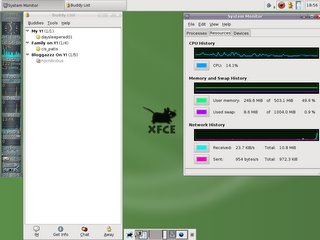Now see, here's a situation where Linux could be a simple free solution. Linux users can use up to 8 (count them XPers) virtual desktops. No hardware upgrades required. Right now, I'm using 4 desktops, with 7 apps working simultaneously to handle my browsing, downloading, music, file-sharing, IM/Chat and system monitoring. All of them are launched in full windows, not minimized. Now, running with a window manager like Xfce, my current setup only uses 247 MB in memory. The bulk of that is taken up by my file-sharing app (50MB). Try that with Windows and you'll feel cramped for space and feel a bit of latency with 256MB in memory.

So try Linux and set your desktop free!







1 comments:
Wow. The second monitor suggestion is quite overboard. I suppose one could just get a bigger monitor, but then again having one that's quite big could be a problem (reaching the taskbar, etc).
I used to set my resolution to the max (12x10) on my 17" monitor. Gave up when I realized that the flicker is unbearable.
For virtual desktops in Linux, GNOME can go up to 36, which is ridiciluosly many, but I suppose people can find a use for it :)
I agree that virtual desktops are really handy, since they allow the separation of task and yes, less clutter. I miss it in Windows. Microsoft does have a powertoy that has the same purpose, but it's annoying enough for me to not even use it, even if it's suppose to do the virtual desktop voodoo Linux does so well :)
Post a Comment